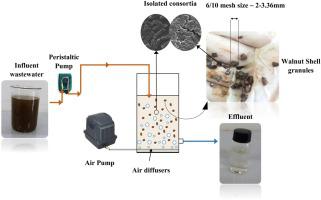Journal of Hazardous Materials ( IF 12.2 ) Pub Date : 2020-06-12 , DOI: 10.1016/j.jhazmat.2020.123197 Reyhaneh Hasanzadeh 1 , Behrooz Abbasi Souraki 2 , Alireza Pendashteh 1 , Gholam Khayati 2 , Fakhru'l-Razi Ahmadun 3

|
Salinity expressed as total dissolved solids (TDS), is the most challenging parameter in bioremediation of produced water which may inhibit the microbial activities and cause sedimentation problems. The present study explores the feasibility of using walnut shell as an inexpensive and accessible adsorbent-carrier for the immobilization of isolated halophilic microorganisms for treatment of synthetic oilfield produced water. The moving bed biofilm reactor (MBBR) was examined with influent chemical oxygen demand (COD) concentrations from 900 to 3600 mg L−1, TDS concentrations from 35,000–200,000 mg L−1, and cycle times from 24 to 72 h. Comparison of the MBBR with the conventional sequencing batch reactor (SBR) indicated that both systems operated at lower influent COD and TDS concentrations satisfactorily; but at higher TDSs (above 150,000 mg L−1) the MBBR was more resistant to the shocks of toxicity (salinity) and organic load relative to the SBR. Also, the effluent turbidity was lower and the free sludge settling property was more favorable in the MBBR with average sludge volume index (SVI) of 38.8 mL g−1 compared to the SBR with SVI of 98.09 mL g−1. Microbial identification confirmed the presence of eight dominant halophilic species which were hydrocarbon degraders and/or denitrifiers.
中文翻译:

悬浮并固定在核桃壳上的分离的嗜盐微生物作为生物载体在油田采出水处理中的应用。
以总溶解固体(TDS)表示的盐度是采出水生物修复中最具挑战性的参数,可能抑制微生物活动并引起沉淀问题。本研究探索了使用核桃壳作为廉价且易于获得的吸附剂载体来固定分离的嗜盐微生物以处理合成油田采出水的可行性。检查了移动床生物膜反应器(MBBR)的进水化学需氧量(COD)浓度为900至3600 mg L -1,TDS浓度为35,000–200,000 mg L -1,周期时间为24至72小时。MBBR与常规测序间歇反应器(SBR)的比较表明,两个系统均能在较低的进水COD和TDS浓度下令人满意地运行。但是在较高的TDS(高于150,000 mg L -1)下,MBBR相对于SBR更能抵抗毒性(盐度)和有机负荷的冲击。此外,与平均污泥体积指数(SVI)为38.8 mL g -1的MBBR相比,SBR为98.09 mL g -1的MBBR的出水浊度更低,自由污泥沉降性能更佳。微生物鉴定证实存在八个主要的嗜盐物种,它们是烃降解剂和/或反硝化剂。











































 京公网安备 11010802027423号
京公网安备 11010802027423号